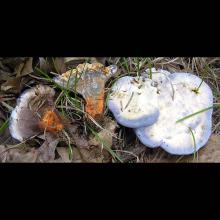Hydnellum caeruleum
Common name:
Blue tooth
Genus:
Hydnellum
Family:
Bankeraceae
Order:
Thelephorales
Hydnellum caeruleum
Common name:
Blue tooth
Genus:
Hydnellum
Family:
Bankeraceae
Order:
Thelephorales
Hydnellum caeruleum
Common name:
Blue tooth
Genus:
Hydnellum
Family:
Bankeraceae
Order:
Thelephorales
Genus (Plantae): Hydnellum
Hydnellum is a genus of tooth fungi in the family Bankeraceae (order Thelephorales). Widely distributed in the Northern Hemisphere, the genus contains around 40 species. The fruitbodies of its members grow by slowly enveloping nearby bits of grass and vegetation. There is great variability in the form of Hydnellum fruitbodies, which are greatly influenced by environmental conditions such as rainfall and humidity, drying winds, and temperature. They are too tough and woody to eat comfortably. Several species have become the focus of increasing conservation concern following widespread declines in abundance.
Hydnellum species produce pigments that have been used to dye textiles. Several chemical compounds—some with unique biological activity—have been isolated and identified from the genus.
One of the better-known species is the unusual pinkish-white Hydnellum peckii, also known as "strawberries and cream" or as the "bleeding tooth fungus" due to the red droplets that appear on the pinkish or whitish fruitbodies. Another species, H. suaveolens, has a strong odor of anise or peppermint.
"Hydnellum is a genus of stipitate hydnaceous fungi that can be recognized by their brown, ornamented basidiospores, leathery texture, and indeterminate, mycorrhizal growth habit. Although previous taxonomic works have been useful, there are many disagreements between authors as to the correct delimitation and placement of Hydnellum species. An extensive historical literature review of the toothed fungi, beginning in 1753, is incorporated, necessitating translation of Latin and French descriptions. Since there are discrepancies in the literature about proper classification and because of only limited recent work on Hydnellum, a re-examination of the species with modern taxonomic methods is warranted. We have undertaken morphological, molecular (DNA sequencing), and chemical (pigment) studies of Hydnellum species. Eighty-seven collections were examined morphologically, and 36 of those collections were analyzed by comparing ITS sequences. Fifteen collections were studied with CHUMS, chemosystematics with high performance liquid chromatography (HPLC) using mass spectroscopy. This method compares species using the presence or absence of chemical compounds to determine relatedness. A total of 54 compounds were analyzed to construct a chemical "sequence" that can be analyzed like a nucleotide sequence, with each compound being analogous to one nucleotide position on the DNA. From this sequence we are able to construct phylogenies that show relatedness of species. All three lines of evidence (morphological, chemical, and DNA) were used to determine final systematic and taxonomic placements of 15 Hydnellum species."
Reference: Wikipedia, Tom Volk's Fungus of the Month

